Combining Research Methods of Interpretative Phenomenological Analysis (IPA) and Visual Art Creation in a Qualitative Study
Helen Elizabeth Seaman
Graduate of University of Hertfordshire’s EdD Programme.

Abstract
From 2017 through to 2020 a qualitative doctoral study was completed using the combined methods of Interpretative Phenomenological Analysis (IPA) and a visual arts-based approach. This is an unusual combination of approaches particularly in a non-health related study. The participants were health professionals but the focus of the study was not their health or ill-health. The EdD was awarded in 2021. This article charts why and how these methods of IPA and visual art creation were chosen and applied, and the advantages and value to research of using this particular combination of approaches. I reflect on how the participants responded to these combined methods and how I as a researcher experienced using collage myself as a reflexive tool throughout my research journey.
Keywords: Phenomenology, Interpretative Phenomenological Analysis (IPA), visual arts-based approach, collage.
Introduction
Health visitors are qualified nurses/midwives who specialise in community public health. They have a universal remit to provide health support, guidance and advice to all families with children under 5 which may extend to other individuals and groups. A qualitative study explored 20 health visitors’ (HVs) perceptions of their professional identity and their experience of living through a time of significant service changes to their practice in one NHS trust in England. The HVs were initially interviewed in 2018 through to 2019. Follow-up interviews commenced from late 2019 through to 2020 including the initial peak of the Covid-19 pandemic. Of the original cohort of 20 participants, eight (8/20) HVs were available for interview pre-pandemic and following a short break (due to a government-imposed ‘stay-at-home’ order), seven (7/20) during the pandemic when safe to do so. The study aimed to gain a deep understanding of the nature and meaning of practitioners’ experience of living through a time of change: specifically, what that experience was like.
This article charts why and how these methods of Interpretative Phenomenological Analysis (IPA) and visual art creation were chosen and applied, and the advantages and value to research of using this specific combination of approaches. As a researcher, I reflect on how the participants reacted to these combined methods and how I as a student researcher experienced using collage myself as a reflexive tool throughout my research journey.
A discussion on phenomenological inquiry, IPA, arts-based research methods and collaging will follow. How the combined methods of IPA and collage were carried out, their combined suitability for this study and the value to research of combining these specific methods are then discussed.
Choice of Research Approaches
This section outlines the concept of phenomenology, the theoretical underpinnings of IPA and its value in researching lived experience. The characteristics of visual art and its value as a research tool with a particular focus on collage are also discussed.
Phenomenology and Interpretative Phenomenological Analysis
‘Phenomenological research is the study of lived experience’ (van Manen, 2016/2015: 9). It is a family of qualitative methods all concerned with human existence and how individuals interact with others and the world around them focussing on how humans perceive things as they ‘appear to consciousness’ (Langdridge, 2007: 10).
IPA was developed in the 1990s ‘explicitly as a psychological methodology concerned with the detailed exploration of individual experience’ (Kirkham, Smith and Havsteen-Franklin, 2015: 398). Despite critics such as Giorgi (2010), van Manen (2017) and Zahavi (2018), who claim that IPA does not have the necessary credentials required to be considered ‘phenomenological’, Smith et al. (2009) argue that IPA is valid as a phenomenological method as it asks the fundamental question, what is this experience like?
IPA’s lived experience is seen afresh through ‘bracketing’ (as far as able) the researcher’s preconceptions and assumptions (Smith et al., 2009). IPA involves hermeneutics (interpretation) – i.e., the part played by the researcher in interpreting the data and sense-making and the ‘back and forth’ movement between the data and other relevant theoretical/empirical work. Another characteristic is the double hermeneutic; the interplay between the participant’s interpretation and sense-making and that of the researcher. The analytical process is methodical, involving looking for descriptive, conceptual, and linguistic elements of each transcription taken in turn, then looking across all accounts for superordinate themes. It offers relatability, rather than generalisable findings as traditionally offered by quantitative studies, i.e., IPA looks to analyse a phenomenon to further understand it and for the reader to make use of the findings if similar circumstances are shared (Dzakiria, 2012).
IPA: characteristics and suitability for the study
The central research aim was to uncover HVs’ understandings of their lived experience of change in a deep, meaningful and nuanced way. A phenomenological method, such as IPA, aims to capture lived experience through the individual’s ‘feelings, thoughts, and perceptions’ (Willig, 2013/2001: 16), which aligned with this research’s focus and was therefore selected. IPA usually focusses on an experience of something significant which was the case for the study participants. It is flexible, but offers a systematic framework for analysis, with guidance for novice researchers which was relevant in this context.
IPA is idiographic, in that the central role always remains with the individual participant and focusses on the person rather than the phenomenon. This focus on the person, which was a key aim of this study, differs from descriptive phenomenology as described by Giorgi (1992) or the search for the ‘essences’ of phenomena as sought by Husserl (Langdridge, 2007). IPA also includes psychological and emotional responses, and embodiment, all of which were again relevant. In addition, IPA attuned with my ontology, epistemology, and a deeply personal desire to explore that which is the most unique, private, and intimate; ‘what it means to be human’ (van Manen, 2016/2015: 12).
I recognised that the participants’ thoughts, feelings and tacit knowledge of their professional identity in the context of change could not be elicited through a conventional interview method alone as it would not surface the depth of understanding sought. For these reasons I sought a holistic approach that combined interviews with data collection through visual art.
Arts-based and embodied research
Arts-based research methods can stimulate awareness, inform and educate. Dance, poetry, model-making, photography, drawing and painting have all been shown to produce rich data, and arts-based research is becoming a widely-respected and a rapidly expanding form of inquiry (Gerstenblatt, 2013).
van Manen (2016/2015: 54) argues that words are inadequate to fully describe experience, claiming that as language is fundamentally a social phenomenon it will inevitably ‘miss the mark’. Visual art however, is a form of communication and expression beyond verbal language (Mannay, 2016) and has the characteristics and power to unlock, surface, and enhance our knowledge of ourselves and our experiences.
Words alone are also not enough to delve deeply into our subconscious where tacit knowledge resides but through visual image creation this knowledge can be awoken and expressed (Halprin, 2003). Further, by liberating tacit knowledge through art deeper levels of knowledge, understanding and experience may be unlocked and fresh ideas developed. Different ways of thinking and perceiving how we understand the world may arise out of art creation (Leavy, 2015/1975), and we may also consider what we think we know in a new light. Art creation helps individuals to make sense of their world and experiences.
Through art we also liberate deep intuitive emotions (Leavy, 2015/1975) which otherwise may remain dormant and unexposed (Spouse, 2000).
Communication is enhanced significantly through the medium of art. It can be pre-reflective, communicating what cannot be easily verbalised; as with Outsider Art, it communicates what is ‘otherwise unsayable’ (Rhodes, 2000: 7) – the ‘inexpressible to be discovered’ (Nizza, Smith and Kirkham, 2018: 169). Indeed, for some individuals, for example the neurodiverse creators of the collective Project Art Works with restricted verbal capability, visual art is their significant form of expressive communication (Project Art Works, 2023). Their art work is free-flowing, spontaneous, and sensuous, rather than bound by intellectual and verbal restraints.
Art creation also involves the creator in an active and embodied felt response (Chilton and Scotti, 2014). The physical body, emotions and thinking are bound together (Halprin, 2003) reflecting Dewey’s ‘body-mind’ concept (Dewey, 1958: 77). Wiebe and Snowber (2011: 111) add that ‘embodied knowing’ is sited in the senses and the ‘sensuous’. Warnock (1989/1987) makes links between imagination, memory, experience, emotions, and education. Imagination ascribes meanings to the things around us and, if applied freely as a creative tool, can enlighten us to what is significant in our experiences.
Despite the clear potential value of art as an effective research tool for data collection, I take the view, agreeing with van Manen (2016/2015) on art, that whether verbal or written, neither art nor art-based methods can completely match the reality of the lived experience itself.
Collage: characteristics and suitability for the study
A visual art approach was chosen as a valuable experiential sense-making method. As well as familiarity with the literature just cited and alongside my creative temperament and personal inclination towards art creation there were nine further reasons that led me to choose collage over other forms of art.
Firstly, my own exposure to art creation and personal encounter with the neurodiverse creators of the collective Project Art Works also inspired me to choose a tool that is spontaneous and communicates beyond words. As an EdD student I had been introduced to collaging as a way to express my thoughts and feelings. Like Culshaw (2019) I had been surprised by the way this medium could unlock ideas and tap into deep-seated emotions.
Secondly, offering participants the opportunity to create a collage at the beginning of the interviews was intended to put them at ease.
Thirdly, this fosters a greater distribution of power than other more researcher-led methods, in line with my view that myself and the participants were equal partners in the research process (Finley, 2008).
Fourthly, bricolage – the experience of constructing artefacts and ideas from ‘whatever comes to hand’ (Merriam-Webster, 2020: online) – offers the bricoleur freedom and licence to activate their imagination, which as discussed helps to bring depth and breadth to one’s thinking.
Fifthly, the interview process was designed to be a pleasant experience for the participants and offered a creative means to explore feelings in a safe and novel way. Roberts and Woods’ (2018) claim that collage creation may also be enjoyable and playful and my own experience of collaging further supported my choice of this approach.
Sixthly, I was particularly drawn to the physicality of collaging. Movement and emotions are interwoven (Fuchs and Koch, 2014) and by inviting participants to create a collage whereby the materials chosen were left unglued and free to be moved, arranged and rearranged, their bodily movements would naturally trigger emotive responses.
Seventhly, collaging is a slow-paced reflective and expressive activity where participants’ thoughts can develop and novel ideas spring forth (Roberts and Woods, 2018).
Eighthly, as discussed, the analytical process of a double hermeneutic in IPA involves myself as researcher in trying to interpret the participants’ own interpretation. Combining both the visual and narrative, the interpretation of the art is embedded and contextualised. The said and unsaid, the intended and unintended cultivate different and diverse ways of knowing (Butler-Kisber, 2008). The analysis involves looking at the ‘wholeness’ of the collages in their entirety (Jongeward, 2015/1975: 255; Roberts and Woods, 2018: 13), and I could ‘visually listen’ to the art and note what appears striking. The characteristics, form, shape, colour and juxtaposition of the materials selected are analysed and, through this, the individual collages can reveal rich insights.
Lastly, collaging materials are inexpensive and readily available. As a student researcher this was a small but reasonably significant bonus.
Data Collection
In this section the data-gathering process will be discussed. This will lead into a detailed discussion of the value to research in combining IPA and collage.
Data were collected from in-person, one-to-one semi-structured interviews. Collage materials were offered at the beginning of every interview followed by IPA-informed key open questions.
Interviews
To begin the interviews, participants were invited to create a collage from a wide range of materials and a choice of plain A2 coloured sugar paper as background (see Figure 1).
Figure 1 Samples of all the materials and coloured paper offered for collaging.

For equity, all participants were offered the same collage materials. The materials offered included ribbons, buttons, feathers, small plastic objects, coloured tissue paper, cotton wool, magazine pages, metal objects such as safety pins, screws and nails, stones, shells, and dried natural vegetation. The same materials were provided again in the follow-up interviews to compare data.
Participants were provided with a previously unseen prompt for their collage. At the initial interviews the prompt given was ‘who are you as a health visitor?’ and at the follow-up interviews a year (plus) later, ‘thinking of this time of change, who are you as a health visitor now?’. Although Spouse (2000) and Pauwels (2010) put forward arguments for familiarising participants with the focus of the study in advance, I decided to provide the prompt only at the beginning of the interview after previously providing it a week in advance in my pilot study. I felt that when the prompt was provided prior to the interview this did not align with eliciting embodied felt responses or capturing participants’ experiences relatively pre-reflectively and spontaneously.
Another choice as researcher was whether participants were to be given the opportunity to review their previous art work at their follow-up interviews. This has been a feature in other studies, where progress through a health issue was being researched such as Shinebourne and Smith’s (2011a) study of addiction and recovery. It was decided that comparing and contrasting thoughts and feelings as depicted in the first collage should not be the focus of the second interview. Instead, the purpose of the second interview was to attend to the present moment and offer participants a way of responding afresh to the revised art prompt, rather than compare with a previous response. The follow-up art prompt (‘thinking of this time of change, who are you as a health visitor now?’) reflected this, aiming again at capturing participants’ pre-reflective responses. It was only in the discussion which followed and in the later analysis that comparisons were made.
Another consideration was whether to leave the participants alone with the art materials or remain present during the creation of their collages. Both ways were tried out in the pilot study. When present, I was able to note their more immediate embodied felt responses, but my presence was distracting when participants felt obliged to converse to me. I decided that the problem of distraction was too great a risk to the participants’ spontaneity and pre-reflective responses to the prompt question if I was present so remained out of the room for the collage creations in all interviews.
Collages
The 33 collages created were personal, unique and very varied as seen in the six examples below in Figures 2 and 3.
Figure 2 Examples of collages from the initial first set of interviews:
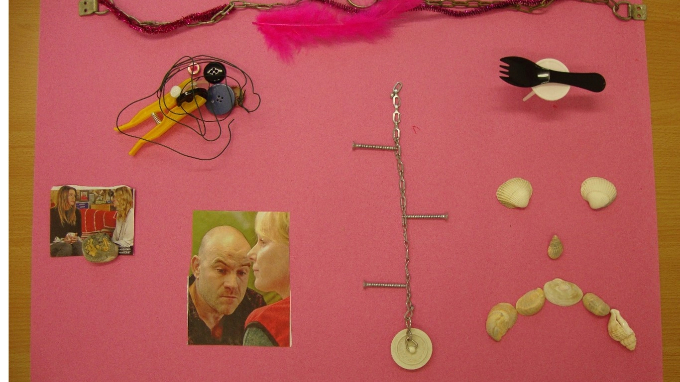
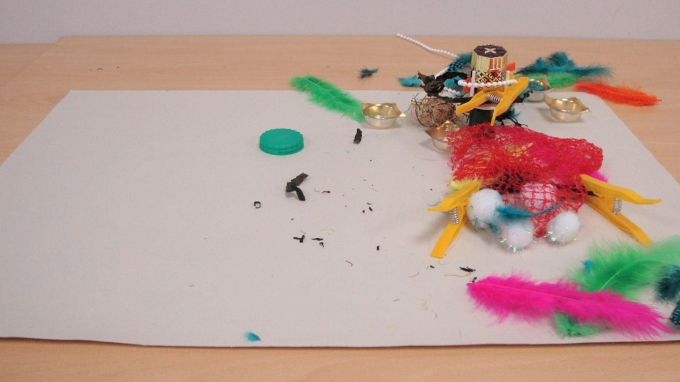
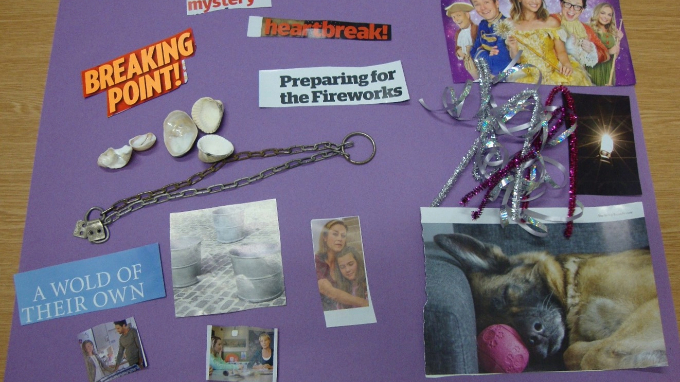
Figure 3 Examples of collages from the follow-up interviews:
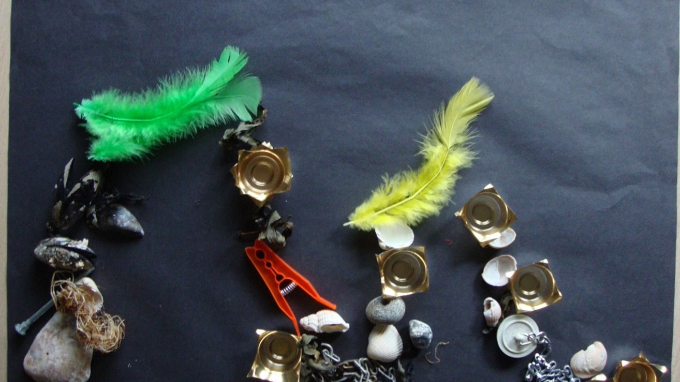
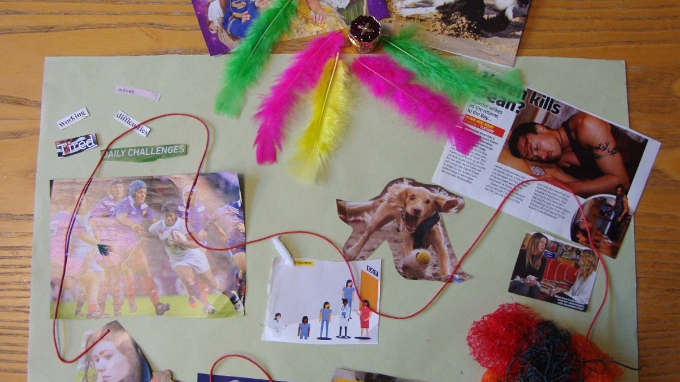
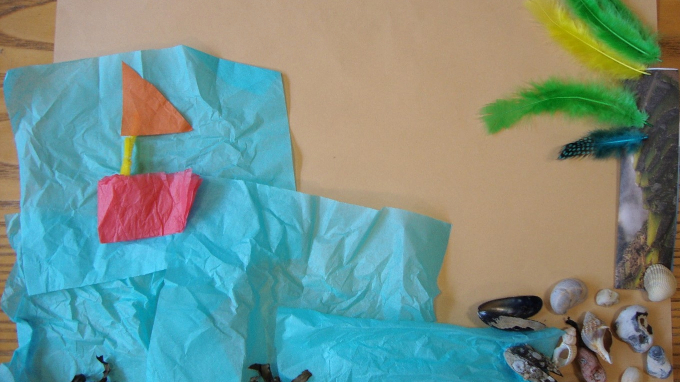
I concur with Mannay (2016), who asserts that the potential benefits of using visual tools in research can only occur if embedded in narrative. This is what I aimed to produce. The collages were not an end in themselves but the participants, if willing, were invited to interpret what they had created. Elicitation interviews followed the collaging to discover further what participants were communicating in their art.
In both the initial (2018-2019) and follow-up interviews (2019-2020), following the collage creations, an IPA-informed semi-structured interview followed beginning with my opening question ‘would you like to tell me about your collage?’ or, for the follow-up interviews, ‘thinking of this time of change, who are you as a health visitor now?’. A small number of key open questions were asked and prompts used to encourage participants to tell me about their experiences. The majority provided detailed explanations for their choice of materials and background colour. The interviews were recorded and transcribed verbatim, and collages photographed, following permission from the participants.
Value of Combining IPA and Collaging in Researching Lived Experience
In this section the value of combining IPA and collaging will be discussed from the participants’ perspective, from my own researcher viewpoint, and in terms of the advantages for the study. (The advantages of collage creation, IPA and their combination are summarised in Table1.)
Table 1. Advantages of combining collage and IPA
| Collage-making at the outset of interview in response to a previously unseen prompt | IPA | Combining Methods |
|---|---|---|
Pre-reflective and spontaneous | Researching lived experience | Captures closely what the experience is like |
Variety of materials | Textual, rich, fine-grained and nuanced data | |
Unglued and moveable materials | Movement of pieces captures deeper and evolving thoughts | |
Large range of collage materials | Idiographic (focus on person not phenomenon) | Individualistic data |
Presented and interpreted by participant | Double-hermeneutic (both participant and interviewer interpret) | Full, rounded interpretation |
Advantages for participants
Almost all the participants enjoyed the experience of collaging. (Only one refused, preferring to respond to the prompt question in writing, which of course was respected.) This included the few who were initially hesitant or daunted by the idea of creating an art piece. Reassuring them that this was not about artistic merit allayed their concerns. Comments received included that the activity was “cathartic”, “fun”, and helped provide them with clarity and focus of thought. The activity was slow-paced, and the participants were encouraged to complete them in their own time. This gave them well-earned quiet time and space away from their busy days. For most, their body language, posture and demeanour following their creations appeared calm and relaxed, and their faces expressed pleasure when appraising their collages. Several openly commented that they had not engaged in art creation for many years and had forgotten how satisfying this activity could be.
For all (n=19) but one of the participants interviewed initially however, the collaging experience surfaced difficult or mixed feelings, and for three even painful feelings. In all but one case this was not in regards to themselves as HVs but in response to the service changes. A similar ratio was seen at the follow-up interviews (n=15) although direct comparisons cannot be made for the final group interviewed as this was in the context of the Covid-19 pandemic. Although it could be argued that this could be construed as a disadvantage, surfacing these deep, often hidden feelings gave participants the opportunity to appraise what was troubling them and consider ways forward to resolve the issues.
Participants were also placed in the position of leading the interview as they took immediate initial ownership through being given the opportunity of creating a collage. Through this opening activity they were at liberty to present at interview what mattered to them and how they felt about living through a time of professional service change. This helped address the thorny issue of the balance of power between the participant and researcher, too often residing solely with the latter. Giving the participants the opportunity to create a collage was also successful in helping to ensure that participants felt that their contributions were important; that they were valued and respected.
The collages created were very varied and deeply personal. The collages were not a device simply to open the interviews but to surface participants’ feelings and thoughts about their lived experiences in ways that a set of semi-structured questions alone could not. The participants’ reflections and thoughts springing from their art helped shape the storytelling of their experiences in personal and individualistic ways. Creating the collages appeared to help participants relax and reflect, and the IPA-informed structure to the interview meant that only a few open questions were required to encourage the participants to speak freely and expansively.
For all but one of the participants the combining of the collaging with discussion was affirming and bought to mind the reasons why they wanted to be HVs. Additionally, in the case of the final participants interviewed during Covid-19, there was a renewed sense of motivation for most.
Advantages for myself as researcher
Throughout the research I also created my own reflexive collages using similar materials to those offered to the participants to record my own thoughts and feelings as the study progressed. I endeavoured to create a quiet, calm and tranquil environment free from distractions to allow my mind space for spontaneity and free-flow. Although I was not being interviewed, in line with a basic tenet of IPA the question such as ‘what is this experience like?’ (Smith et al., 2009), I let my mind flow and tried to ‘be in the moment’ of how it felt for me at that point in the research process. Following my collaging I would then interpret the meaning within what I had created pre-reflectively. I discovered that trying to place oneself in a spontaneous and pre-reflective state without distraction is difficult to do and was pleased that I had offered the participants a calm quiet space away from noise and interruption.
I found the process of creating my own collages liberating and motivating although sometimes emotionally challenging. Through creating, interpreting and making sense of my collages, I was able to think more clearly as to what was going well and what would benefit from more thought, investigation, or change. As a researcher I found du Plock’s (2008: 47) concept of the ‘research trajectory’ useful in informing at what point I was entering the inquiry and what therefore was being illuminated (and what was not). I began the study at a time when the HVs were already beginning to experience the initial effects of significant service change. I was aware however that more changes were pending after my research had concluded and therefore the HVs’ responses to these would not be included in my study. My personal collages were valuable ‘markers’ in identifying the specific time I was involved in the ongoing changes and where I was in my own research journey.
Advantages for the study
Butler-Kisber and Poldma (2010) describe three ways in which collage can be used in research: for reflection, elicitation and to conceptualise ideas. In this study, the process of reflection, elicitation and conceptualisation of ideas followed the participants’ collage creations as they interpretated and discussed their artwork. Combining collage with IPA led to participants providing full and detailed accounts of their experiences of living through a significant event. The combined methods complemented one another - one leading into and informing the other. Only a few IPA-informed open-ended questions and prompts were required to encourage expansive and fluid verbal responses. The physicality of unglued collage materials meant that the pieces could be moved around during the art creation and afterwards during the discussion adding another layer of complexity, and supported the development of thoughts and feelings. Examples of this were noted as several participants, when describing their collages, moved the materials around, pausing to reflect further. During the discussion many participants returned to their collages using the images to describe their experiences in greater depth and detail.
The characteristics and wide choice of the materials added another layer of interest, and arguably encouraged a greater depth and complexity of expression than a two-dimensional drawing could produce. The choice of certain materials reflected a range of emotions. Soft or colourful materials such as feathers and tissue paper usually reflected positive emotions whereas the choice and use of materials such as sharp nails and dry, dead vegetation often reflected sadness, frustration or loss. Similarly, the choice of background colour represented the participants’ overall emotional response to the prompt questions (see Figure 1).
The combined methods were very successful in finding out and understanding the participants’ lived experiences of service change. The combination of collaging and IPA-informed discussion provided accounts and stories which were rich and nuanced, arguably beyond what each alone would have produced. Viewed collectively, a deep understanding of the HVs’ lived experiences was gained through attention to contrasts, comparisons, and similarities.
Combining IPA and collage as research methods to investigate a non-health-related topic appears rare despite the growing interest in visual arts-based approaches in research (Mannay, 2016). An arts-based method combined with IPA has been used in previous research which is directly (ill) health-related, such as Kirkham, Smith and Havsteen-Franklin’s (2015) study of patients experiencing chronic pain and Shinebourne and Smith’s (2011b) research into addiction recovery. However, the method chosen was pictorial drawn images combined with IPA not collage. The participants in this study were all health visitors but this was their profession and this study was not a focus on their health per se.
On a practical note, the collage materials were relatively inexpensive and easily replaceable. Creating artefacts meant that the collages could be photographed and reviewed many times over during the analysis.
There were very few challenges to overcome. A practical consideration was that a substantial quantity of materials needed to be transported from venue to venue. As well as the standard safety precautions, during the Covid-19 pandemic the materials had to be washed or left untouched for a period of time between interviews.
On some occasions the collaging and interview experience surfaced painful feelings in the participants, reminding me of my ethical responsibilities towards the participants and follow-up support was arranged if required.
Conclusion
Although I am mindful of van Manen’s (2016/2015) argument that descriptions of lived experience cannot completely match the actual experience itself, the combination of IPA and collaging was very successful in meeting this study’s aims. For most of the participants collaging offered a quiet space and time alone to enjoy the opportunity to be spontaneous and creative, which was unusual and very enjoyable for many. Through offering a wide variety of materials of different colours and textures that could be arranged and rearranged, deep, often hidden emotions and thoughts were surfaced. Although the service changes felt challenging and disturbing to almost all the participants in the initial and follow-up interviews, it was not their belief in their work as health visitors that was in doubt. Indeed, for many, the interview experience affirmed their commitment to the profession and highlighted why they enjoyed and valued their work. Additionally, for a few, some of the challenges of change came into sharper focus and their thoughts turned to how these could be met and resolved.
For the study, the methods produced textual, rich, fine-grained, vivid and nuanced descriptions of the participants’ experience of living through service change. The methods complemented one another very well, with one leading into, and informing the other. Having experienced the fruitfulness of combining collage and IPA as research methods, I am doubtful that I would have acquired such rich data from a verbal IPA-informed interview alone. In response to the very few IPA informed questions that were required, full and detailed accounts of participants’ lived experience were offered arising from their interpretation of their collages.
I would encourage other researchers to consider combining IPA and visual art as research approaches if their aim is to investigate what it means to their participants to live through a significant life experience.
